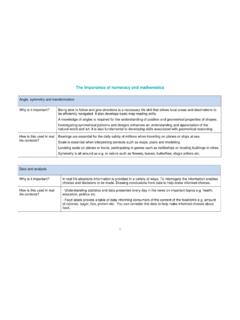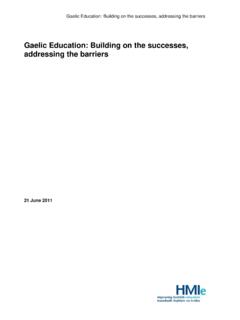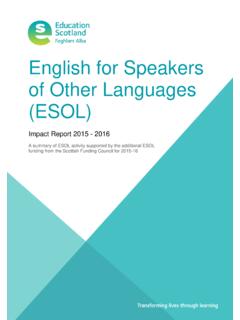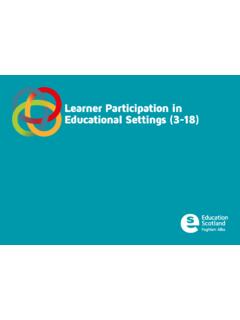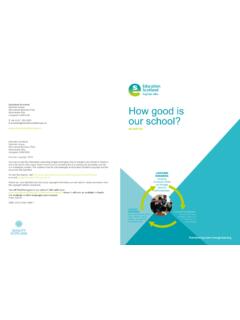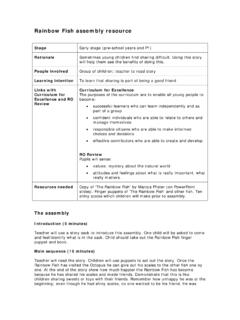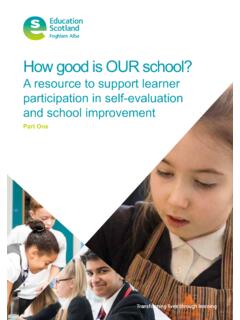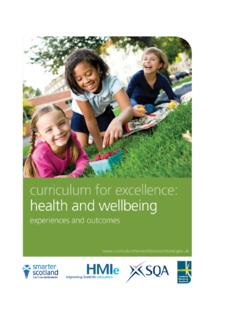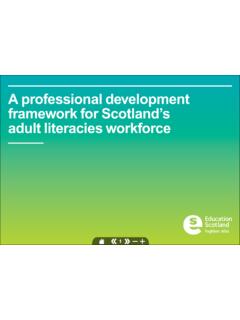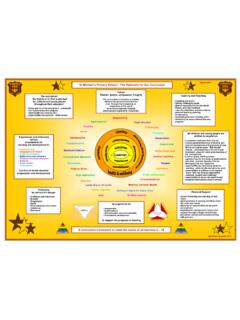Transcription of Benchmarks Physical Education - Education Scotland
1 Benchmarks Physical Education March 20172 Education Scotland Guidance on using Benchmarks for Assessment March 2017 Education Scotland s Curriculum for Excellence (CfE) Statement for Practitioners (Aug 2016) stated that the two key resources which support practitioners to plan learning, teaching and assessment are: Experiences and Outcomes Benchmarks Benchmarks have been developed to provide clarity on the national standards expected within each curriculum area at each level. They set out clear lines of progression in literacy and English and numeracy and mathematics , and across all other curriculum areas from Early to Fourth Levels (First to Fourth Levels in Modern Languages). Their purpose is to make clear what learners need to know and be able to do to progress through the levels, and to support consistency in teachers and other practitioners professional judgements. Skills development is integrated into the Benchmarks to support greater shared understanding.
2 An understanding of skills and how well they are developing will enable learners to make links between their current learning and their future career options and employment. Benchmarks draw together and streamline a wide range of previous assessment guidance (including significant aspects of learning, progression frameworks and annotated exemplars) into one key resource to support teachers and other practitioners professional judgement of children s and young people s progress across all curriculum areas. Benchmarks have been designed to support professional dialogue as part of the moderation process to assess where children and young people are in their learning. They will help to support holistic assessment approaches across learning. They should not be ticked off individually for assessment purposes. Benchmarks for literacy and numeracy should be used to support teachers professional judgement of achievement of a level.
3 In other curriculum areas, Benchmarks support teachers and other practitioners to understand standards and identify children s and young people s next steps in learning. Evidence of progress and achievement will come from a variety of sources including: observing day-to-day learning within the classroom, playroom or working area; observation and feedback from learning activities that takes place in other environments, for example, outdoors, on work placements; coursework, including tests; learning conversations; and planned periodic holistic assessment. 3 Benchmarks in curriculum areas Benchmarks in each curriculum area are designed to be concise and accessible, with sufficient detail to communicate clearly the standards expected for each curriculum level. Teachers and other practitioners can draw upon the Benchmarks to assess the knowledge, understanding, and skills for learning, life and work which children are developing in each curriculum area.
4 In secondary schools, Benchmarks can support subject specialist teachers in making robust assessments of learners progress and the standards they achieve. They will help teachers ensure that learners make appropriate choices and are presented at an appropriate level for National Qualifications in the senior phase. This can help avoid excessive workload for teachers and unnecessary assessments for learners. For example, learners should have achieved relevant Fourth level Experiences and Outcomes before embarking on the National 5 qualifications. Schools should take careful account of this when options for S4 are being agreed. Benchmarks should be used to help with these important considerations. Literacy and numeracy In literacy and numeracy , Benchmarks support teachers professional judgement of achievement of a level. Teachers professional judgements will be collected and published at national, local and school levels.
5 It is important that these judgements are robust and reliable. This can only be achieved through effective moderation of planning learning, teaching and assessment. Achievement of a level is based on teacher professional judgement, well informed by a wide range of evidence. Benchmarks should be used to review the range of evidence gathered to determine if the expected standard has been achieved and the learner has: achieved a breadth of learning across the knowledge, understanding and skills as set out in the experiences and outcomes for the level; responded consistently well to the level of challenge set out in the Experiences and Outcomes for the level and has moved forward to learning at the next level in some aspects; and demonstrated application of what they have learned in new and unfamiliar situations. It is not necessary for learners to demonstrate mastery of every individual aspect of learning within Benchmarks at a particular level and before moving on to the next level.
6 However, it is important that there are no major gaps in children s and young people's learning when looking across the major organisers in each curriculum area. 4 Planning learning, teaching and assessment using the Benchmarks In addition to the Curriculum for Excellence (CfE) Statement for Practitioners from HM Chief Inspector of Education , August 2016 on the purpose and use of Benchmarks , teachers and other practitioners should note the following advice. KEY MESSAGES WHAT TO DO KEY MESSAGES WHAT TO AVOID Use literacy and numeracy Benchmarks to help monitor progress towards achievement of a level, and to support overall professional judgement of when a learner has achieved a level. Avoid undue focus on individual Benchmarks which may result in over-assessing or recording of learners progress. Become familiar with other curriculum area Benchmarks over time. Avoid the requirement to spend time collating excessive evidence to assess learners achievement.
7 Use Benchmarks to help assess whether learners are making suitable progress towards the national standards expected and use the evidence to plan their next, challenging steps in learning. There is no need to provide curriculum level judgements in all curriculum areas stick to literacy and numeracy . Discuss Benchmarks within and across schools to achieve a shared understanding of the national standards expected across curriculum areas. Do not create excessive or elaborate approaches to monitoring and tracking. Do not assess Benchmarks individually. Plan periodic, holistic assessment of children s and young people s learning. Do not tick off individual Benchmarks . 5 Early Level Health and Wellbeing ( Physical Education ) Experiences and Outcomes for planning learning, teaching and assessment Benchmarks to support practitioners professional judgement Physical Competencies Kinaesthetic Awareness Balance and Control Coordination and Fluency Rhythm and Timing Gross and Fine Motor Skills I am learning to move my body well, exploring how to manage and control it and finding out how to use and share space.
8 HWB 0-21a I am developing my movement skills through practice and energetic play. HWB 0-22a Shows awareness of personal space ( where body ends and space begins). Moves at different speeds, levels and directions with others in a designated space. Shows awareness of body parts and body positions when performing a range of different movements. Shows control of personal space and body parts when moving. Holds balance in various shapes and maintains balance when moving. Is beginning to manipulate objects as part of energetic play. Links movements together (moves body or parts of body in order). Is beginning to move with purpose. Is beginning to develop knowledge and understanding of what a quality movement looks like and feels like. Demonstrates how to use repeated patterns of movement to create simple sequences, for example, one foot to two feet jumping.
9 Responds with movement, for example, jump-clap-turn to recognised rhythm, beat, music, words. Performs basic components of movement, for example, run, jump, gallop, transfer of weight from one foot to another. Is beginning to perform movement skills in sequence, for example, catch an object with two hands. Is beginning to demonstrate eye/hand and eye/foot 6 co-ordination required for movement skills, for example, pass object from one hand to the other. Cognitive Skills Focus and Concentration Cue Recognition Sequential Thinking Prioritising Decision Making Multi-processing Problem Solving Creativity I am learning to move my body well, exploring how to manage and control it and finding out how to use and share space. HWB 0-21a I am developing my movement skills through practice and energetic play.
10 HWB 0-22a Focuses on task and pays attention to stimuli, for example, instructions from a practitioner. Recognises external cues that need an immediate response, for example, starting and stopping. Remembers two-step simple instructions, for example, bounce the ball and then change direction. Works out the order for dealing with information (or tasks). Repeats tasks in the correct sequence. Makes decisions in response to simple tasks, for example, knowing when to start and stop. Listens to and makes sense of two/three pieces of information, for example, bounce the ball when moving forwards. Uses prior knowledge, and identifies key information to help form a solution. Moves in response to a variety of stimuli. Demonstrates imagination through energetic play. 7 Personal Qualities Motivation Confidence and Self-esteem Determination and Resilience Responsibility and Leadership Respect and Tolerance I am developing my movement skills through practice and energetic play.
